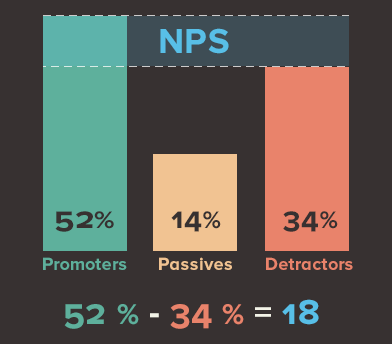The Net Promoter Score® (NPS) is a renowed metric that companies from a wide range of industries use in order to measure the loyalty of their customers. The NPS gives insight to, not only how loyal customers are, but how they actually behave after their experience with a given company - all based on the answers to one important question.
The NPS® was born in 2003 when Fred Reicheld, its creator, saw the need for creating a new and clear way in which organisations could measure how well they were treating the people they affected, and how effective they were at generating loyalty. Over time, the NPS® has evolved into not only being a simple metric, but a whole system that organisations use to empower employees and fuel growth. Today, NPS® is a common standard used by a large number of world-known companies that want to monitor their guest/customer satisfaction, including Apple, Delta Airlines and Marriott among many others.
From the very start, NPS® has been a part of Loopon. Our surveys always include the question the NPS® is based upon as the first one that guests are asked to answer to. While future posts will cover the long term benefits of using NPS® as a system, and its tight correlation with growth and revenue, the present post is meant to help you understand how the score is calculated and the evident benefits of using it.
How are my guests classified?
The NPS® is measured with a simple yet critical question: How likely is it that you would recommend the hotel to a friend or colleague?
Guests are asked to answer the question on a scale from 10 (Extremely likely) to 0 (Extremely unlikely), and they can consequently be classified in one of three different groups:
Response 9-10: Promoters
Guests that give a score of 9 or 10 are classified as promoters. They are enthusiastic guests that are very satisfied with their stay and feel they have been enriched by staying at your hotel. They will behave like loyal customers and will talk up the company to friends and colleagues, just as the answer to the question implies.
Response 7-8: Passives
Those that answer with a 7 or 8 are passives, they are passively satisfied but are not loyals. They make few and unenthusiastic referrals and cannot be counted on as long-term assets because they can be easily wooed by the competition.
Response 0-6: Detractors
Lastly, those that answer from 0 to 6 are classified as detractors, indicating that they are not satisfied with the stay and would most likely not book your hotel again. This group bad-mouths your hotel to friends and colleagues and their behaviour can destroy employee motivation and pride.

F. Reicheld created these three clusters based on the correlation between how customers behave and how they answer the question. He found that promoters reported the highest repurchase rates and accounted for more than 80% of referrals. Those that were passives had repurchase rates that were often 50% lower than those of promoters. And finally, detractors accounted for more than 80% of negative word-of-mouth comments.
How is the score calculated?
The NPS® is calculated as the difference between the percentage of your guests who are promoters and the percentage who are detractors. The score can range from -100, meaning everyone is a detractor, to 100, meaning everyone is a promoter.
For example: if a 52% of your guests are promoters and a 34% are detractors, your NPS® would be positive (18). But if your promoters sum up to 20% and your detractors to 35%, then your NPS® would be negative (-15).

Why is the NPS® a part of our surveys?
The NPS® is known for being tightly correlated to growth and revenue because the metric is based on a question that asks about an actual behaviour: the act of recommending to others. A promoter you managed to please over the weekend is not only one more loyal guest who will come back to you, but could actually translate into four more new guests. NPS® can thus be used to monitor changes in guest satisfaction over time and how they correlate to profits.
The NPS® lets you quickly classify your guests according to how they feel about their stay. However, the follow-up questions let you uncover the reasons for their classification and are the tool to use in order to understand how your guests truly feel. By doing so you will not only be able to respond to them in a better way, but also improve based on their feedback and create even more promoters.
All in all, the NPS® is a strong metric that can help you measure how well you are doing at enriching the lives of all your guests. While categorisation is just the first step, the real work is done by understanding guests' feedback and taking action in order to see the NPS®, and profits, increase over time. We will therefore return shortly with more blog posts on how NPS® can be successfully integrated in your strategy and real case studies that show the clear correlation between NPS® and growth.
